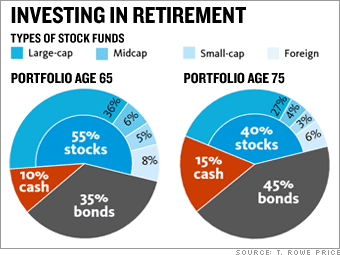To keep inflation from sapping your purchasing power over the course of retirement, you need to keep your savings growing at a decent pace. The surest way to do that is to invest a portion of your portfolio in stocks.
Stocks offer another advantage. Because they tend to deliver the biggest long-term returns, owning them can help you maintain higher account balances than you would otherwise have, even as you're drawing money from your savings. That gives you a larger cushion for unexpected expenses - whether it's a new roof or a big health-care bill.
How much of your savings should you devote to stocks? The idea is to have enough to get the benefits of stocks' higher returns, but not so much that a market slide would so decimate your savings that your standard of living falls.
Generally, you should have around 55% of your savings in stocks at age 65. You can then gradually scale back that percentage to give yourself more protection from market turbulence as you age (see the model portfolios above).
Don't forget, though, that these are just guidelines. If you've got enough saved that a drop in the stock market won't have much impact on your lifestyle, you can hold a larger equity stake. But if a market reversal would deplete your portfolio, you'll want to be more conservative.
Remember too, that you can't afford to wimp out. Playing it too safe is actually dangerous: You may not be able to get the income you need for as long as you need it.

